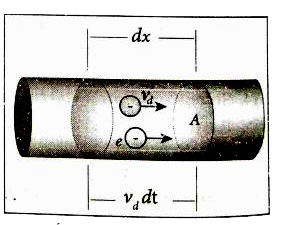Describe the microscopic model of current and obtain general from of Ohm's law. Solution in Tamil

Microscopic model of current: Consider a conductor with area of cross-section A and an electric field →E applied from right to left. Suppose there are n electrons per unit volume in the conductor and assume that all the electrons move with the same drift velocity →vd.
The drift velocity of the electrons =vd
The electrons move through a distance dx within a small interval of dt
vd=dxdt,dx=vddt ...(1)
Since A is the area of cross section of the conductor, the electrons available in the volume or length dx is
= volume × number per unit volume
=adx×n ...(2)
Substituting for dx from equation (1) in (2)
=(Avddt)n
Total charge in volume element dQ= (charge) × (number of electrons in the volume element)
dQ=(e)(Avddt)n
Hence the current, I=dQdt=neAvddtdt
I=neAvd ...(3)
Current density (J): The current density (J) is defined as the current per unit area of cross section of the conductor
J=1A
The S.I. unit of current density, Am2(or)Am−2
J=neAvdA (from equation 3)
J=nevd ...(4)
the above expression is valid only when the direction of the current is perpendicular to the area A. In general, the current density is a vector quantity and it is given by
→J=ne→vd
Substituting →vd from equation →vd=−eτm→E
→J=−n.e2τm→E ...(5)
→J=−σ→E
But conventionally, we take the direction of (conventional) current density as the direction of electric field. So the above equation becomes
→J=σ→E
where σne2τm is called conductivity.
The equation 6 is called microscopic form of ohm.s law.
Topper's Solved these Questions
- CURRENT ELECTRICITYBOOK - FULL MARKSCHAPTER - CURRENT ELECTRICITYEXERCISE - TEXTBOOK EVALUATION (Numerical Problems)
15 Videos
- CURRENT ELECTRICITYBOOK - FULL MARKSCHAPTER - CURRENT ELECTRICITYEXERCISE - Additional Questions Solved (Choose the correct answer)
41 Videos
- CURRENT ELECTRICITYBOOK - FULL MARKSCHAPTER - CURRENT ELECTRICITYEXERCISE - TEXTBOOK EVALUATION (Short Answer Questions)
21 Videos
- COMMUNICATION SYSTEMSBOOK - FULL MARKSCHAPTER - COMMUNICATION SYSTEMSEXERCISE - ADDITIONAL QUESTIONS (Additional problems)
3 Videos
- DUAL NATURE OF RADIATION AND MATTERBOOK - FULL MARKSCHAPTER - DUAL NATURE OF RADIATION AND MATTEREXERCISE - ADDITIONAL QUESTIONS -( ADDITIONAL NUMERICAL PROBLEMS : )
10 Videos
Similar Questions
The following graphs represent the current versus voltage and voltage versus current for the six conductors A,B,C,D,E and F. Which conductor has least resistance and which has maximum resistance?
View SolutionWhen current I flows through a wire, the drift velocity of the electrons is v. When current 2I flows through another wire of the same material having double the length and area of cross-section, the drift velocity of the electrons will be
View SolutionWhy current is a scalar?
View SolutionA radio can tune into any station in the 7.5 MHz to 12 MHz band. What is the corresponding wavelength band ?
View SolutionIf a light of wavelength 4950 Å is viewed as a continuous flow of photons, what is the energy of each photon in eV ? (Given h=6.6×10−34Js, c =3×108ms−1)
View SolutionAssertion: Ohm's law is not valid if current depends on voltage non-linearly.
Reason: Ohm's law is a fundamental law of nature.
View Solutionओम के नियम के अनुसार विभवान्तर व धारा के बीच ग्राफ होगा एक -
View Solutionओम के नियम के अनुसार विभवान्तर व धारा के बीच ग्राफ होगा एक
View SolutionDescribe Holliday model for general recombination
View SolutionDescribe the microscopic model of current and obtain general from of Ohm's law.
View SolutionObtain the macrscopic form of Ohm's law form its microscopic form and discuss its limitation.
View SolutionState macroscopic form of Ohm's law.
View SolutionObtain the macrscopic form of Ohm's law form its microscopic form and discuss its limitation.
View SolutionElectric Current | Current Density | OHM'S Law
View SolutionWhat is current density ? Derive Ohm's law in form of current density?
View SolutionAssertion: Ohm's law is not valid if current depends on voltage non-linearly.
Reason: Ohm's law is a fundamental law of nature.
View Solution
